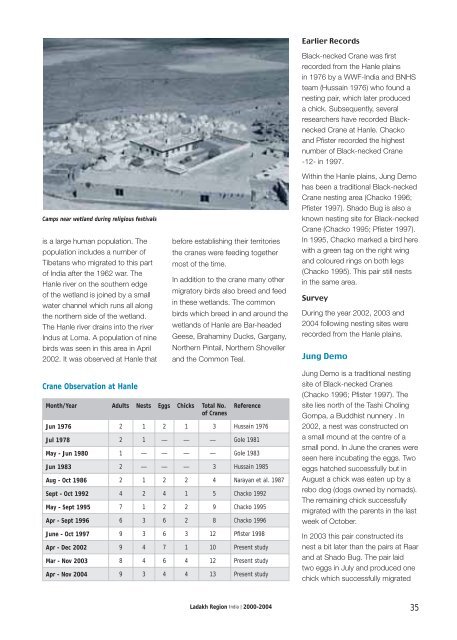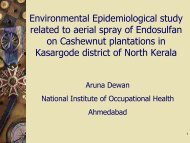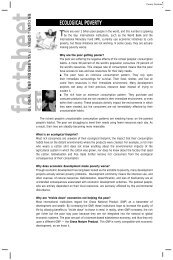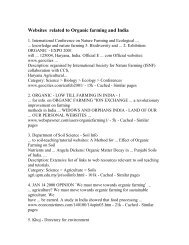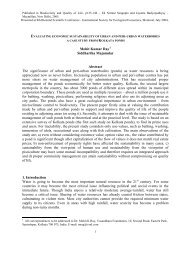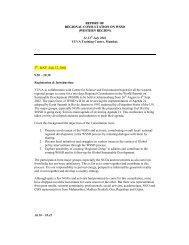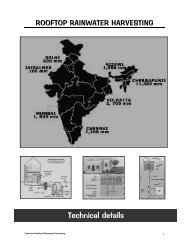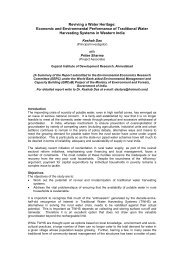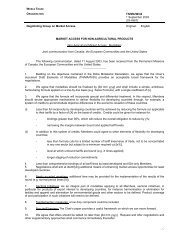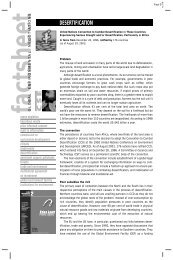Black-necked Crane - WWF-India
Black-necked Crane - WWF-India
Black-necked Crane - WWF-India
You also want an ePaper? Increase the reach of your titles
YUMPU automatically turns print PDFs into web optimized ePapers that Google loves.
Camps near wetland during religious festivals<br />
is a large human population. The<br />
population includes a number of<br />
Tibetans who migrated to this part<br />
of <strong>India</strong> after the 1962 war. The<br />
Hanle river on the southern edge<br />
of the wetland is joined by a small<br />
water channel which runs all along<br />
the northern side of the wetland.<br />
The Hanle river drains into the river<br />
Indus at Loma. A population of nine<br />
birds was seen in this area in April<br />
2002. It was observed at Hanle that<br />
before establishing their territories<br />
the cranes were feeding together<br />
most of the time.<br />
In addition to the crane many other<br />
migratory birds also breed and feed<br />
in these wetlands. The common<br />
birds which breed in and around the<br />
wetlands of Hanle are Bar-headed<br />
Geese, Brahaminy Ducks, Gargany,<br />
Northern Pintail, Northern Shoveller<br />
and the Common Teal.<br />
Earlier Records<br />
<strong>Black</strong>-<strong>necked</strong> <strong>Crane</strong> was fi rst<br />
recorded from the Hanle plains<br />
in 1976 by a <strong>WWF</strong>-<strong>India</strong> and BNHS<br />
team (Hussain 1976) who found a<br />
nesting pair, which later produced<br />
a chick. Subsequently, several<br />
researchers have recorded <strong>Black</strong><strong>necked</strong><br />
<strong>Crane</strong> at Hanle. Chacko<br />
and Pfi ster recorded the highest<br />
number of <strong>Black</strong>-<strong>necked</strong> <strong>Crane</strong><br />
-12- in 1997.<br />
Within the Hanle plains, Jung Demo<br />
has been a traditional <strong>Black</strong>-<strong>necked</strong><br />
<strong>Crane</strong> nesting area (Chacko 1996;<br />
Pfi ster 1997). Shado Bug is also a<br />
known nesting site for <strong>Black</strong>-<strong>necked</strong><br />
<strong>Crane</strong> (Chacko 1995; Pfi ster 1997).<br />
In 1995, Chacko marked a bird here<br />
with a green tag on the right wing<br />
and coloured rings on both legs<br />
(Chacko 1995). This pair still nests<br />
in the same area.<br />
Survey<br />
During the year 2002, 2003 and<br />
2004 following nesting sites were<br />
recorded from the Hanle plains.<br />
Jung Demo<br />
<strong>Crane</strong> Observation at Hanle<br />
Month/Year Adults Nests Eggs Chicks Total No.<br />
of <strong>Crane</strong>s<br />
Reference<br />
Jun 1976 2 1 2 1 3 Hussain 1976<br />
Jul 1978 2 1 — — — Gole 1981<br />
May - Jun 1980 1 — — — — Gole 1983<br />
Jun 1983 2 — — — 3 Hussain 1985<br />
Aug - Oct 1986 2 1 2 2 4 Narayan et al. 1987<br />
Sept - Oct 1992 4 2 4 1 5 Chacko 1992<br />
May - Sept 1995 7 1 2 2 9 Chacko 1995<br />
Apr - Sept 1996 6 3 6 2 8 Chacko 1996<br />
June - Oct 1997 9 3 6 3 12 Pfister 1998<br />
Apr - Dec 2002 9 4 7 1 10 Present study<br />
Mar - Nov 2003 8 4 6 4 12 Present study<br />
Apr - Nov 2004 9 3 4 4 13 Present study<br />
Jung Demo is a traditional nesting<br />
site of <strong>Black</strong>-<strong>necked</strong> <strong>Crane</strong>s<br />
(Chacko 1996; Pfi ster 1997). The<br />
site lies north of the Tashi Choling<br />
Gompa, a Buddhist nunnery . In<br />
2002, a nest was constructed on<br />
a small mound at the centre of a<br />
small pond. In June the cranes were<br />
seen here incubating the eggs. Two<br />
eggs hatched successfully but in<br />
August a chick was eaten up by a<br />
rebo dog (dogs owned by nomads).<br />
The remaining chick successfully<br />
migrated with the parents in the last<br />
week of October.<br />
In 2003 this pair constructed its<br />
nest a bit later than the pairs at Raar<br />
and at Shado Bug. The pair laid<br />
two eggs in July and produced one<br />
chick which successfully migrated<br />
Ladakh Region <strong>India</strong> | 2000-2004 35


